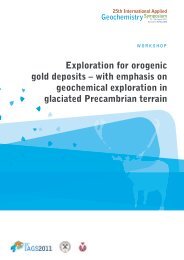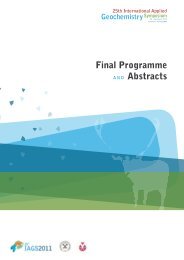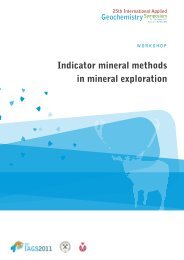IOCG and Porphyry-Cu deposits in Northern Finland ... - IAGS 2011
IOCG and Porphyry-Cu deposits in Northern Finland ... - IAGS 2011
IOCG and Porphyry-Cu deposits in Northern Finland ... - IAGS 2011
You also want an ePaper? Increase the reach of your titles
YUMPU automatically turns print PDFs into web optimized ePapers that Google loves.
Fig. 2. Hannuka<strong>in</strong>en deposit open pits <strong>in</strong> Kolari, F<strong>in</strong>l<strong>and</strong> dur<strong>in</strong>g w<strong>in</strong>ter 2009.<br />
Photo courtesy of Northl<strong>and</strong> Resources S.A.<br />
Geological <strong>and</strong> tectonic evolution<br />
of the northern part of the<br />
Fennosc<strong>and</strong>ian Shield<br />
Stefan Bergman<br />
Geological Survey of Sweden, Uppsala, Sweden<br />
Pär Weihed, Olof Mart<strong>in</strong>sson<br />
Luleå University of Technology, Luleå, Sweden<br />
Pasi Eilu<br />
Geological Survey of F<strong>in</strong>l<strong>and</strong>, Espoo, F<strong>in</strong>l<strong>and</strong><br />
Markku Ilj<strong>in</strong>a<br />
Geological Survey of F<strong>in</strong>l<strong>and</strong>, Rovaniemi, F<strong>in</strong>l<strong>and</strong><br />
Regional geology<br />
The oldest preserved cont<strong>in</strong>ental crust <strong>in</strong> the<br />
Fennosc<strong>and</strong>ian Shield was generated dur<strong>in</strong>g the<br />
Saamian Orogeny at 3.1–2.9 Ga (Fig. 1) <strong>and</strong> is<br />
dom<strong>in</strong>ated by gneissic tonalite, trondhjemite <strong>and</strong><br />
granodiorite. Rift- <strong>and</strong> volcanic arc-related greenstones,<br />
subduction-generated calc-alkal<strong>in</strong>e volcanic<br />
rocks <strong>and</strong> tonalitic-trondhjemitic igneous rocks<br />
were formed dur<strong>in</strong>g the Lopian Orogeny at 2.9–2.6<br />
Ga. Only a few Archaean economic to subeconom<br />
ic m<strong>in</strong>eral <strong>deposits</strong> have been found <strong>in</strong> the shield,<br />
<strong>in</strong>clud<strong>in</strong>g orogenic gold, BIF <strong>and</strong> Mo occurrences,<br />
<strong>and</strong> ultramafic-to mafic-hosted Ni-<strong>Cu</strong> (Frietsch et al.<br />
1979, Gaál 1990, Weihed et al. 2005).<br />
Dur<strong>in</strong>g the Palaeoproterozoic, Sumi-Sariolian<br />
(2.5–2.3 Ga) clastic sediments, <strong>in</strong>tercalated with<br />
volcanic rocks vary<strong>in</strong>g <strong>in</strong> composition from komatiitic<br />
<strong>and</strong> tholeiitic to calc-alkal<strong>in</strong>e <strong>and</strong> <strong>in</strong>termediate to<br />
felsic, were deposited on the deformed <strong>and</strong> metamorphosed<br />
Archaean basement dur<strong>in</strong>g extensional<br />
events. Layered <strong>in</strong>trusions, most of them with Cr,<br />
Ni, Ti, V <strong>and</strong>/or PGE occurrences, represent a major<br />
magmatic <strong>in</strong>put at 2.45–2.39 Ga (Amel<strong>in</strong> et al. 1995,<br />
Mutanen 1997, Alapieti & Laht<strong>in</strong>en 2002). Periods<br />
of arenitic sedimentation preceded <strong>and</strong> followed<br />
extensive komatiitic <strong>and</strong> basaltic volcanic stages at<br />
about 2.2, 2.13, 2.05 <strong>and</strong> 2.0 Ga <strong>in</strong> the northeastern<br />
part of the Fennosc<strong>and</strong>ian Shield dur<strong>in</strong>g extensional<br />
events (Mutanen 1997, Lehtonen et al. 1998, Rastas<br />
et al. 2001). Associated with the subaquatic extrusive<br />
<strong>and</strong> volcaniclastic units, there are carbonate<br />
rocks, graphite schist, iron formation <strong>and</strong> stratiform<br />
sulphide occurrences across the region.<br />
Svecofennian subduction-generated calcalkal<strong>in</strong>e<br />
<strong>and</strong>esites <strong>and</strong> related volcaniclastic sedimentary<br />
units were deposited around 1.9 Ga <strong>in</strong> the<br />
northern Fennosc<strong>and</strong>ia <strong>in</strong> a subaerial to shallowwater<br />
environment. In the Kiruna area, the 1.89 Ga<br />
Kiirunavaara Group rocks (formerly Kiruna Porphy<br />
9






